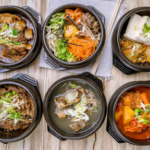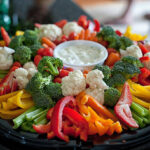Introduction
The Pu Pu Platter is an iconic dish in American-Chinese cuisine, known for offering a variety of appetizers on one large platter. It combines multiple small dishes, often fried or grilled, and is meant to be shared among a group. Although it is a popular item in Chinese-American restaurants, its origins are more diverse than one might think. Starting in Hawaii as a traditional assortment of snacks, the Pu Pu Platter has grown into a beloved part of American dining culture. In this article, we will explore the history, evolution, ingredients, and cultural significance of it, along with how it has become a symbol of fusion cuisine in the U.S.
The History and Cultural Significance of the Pu Pu Platter
1.1. Early Roots of the Pu Pu Platter in Hawaii
The Pu Pu Platter began as a Hawaiian concept, where the word “pu pu” refers to an assortment of small dishes or appetizers. Historically, these platters were served at Hawaiian luaus and social gatherings, featuring a mix of traditional island foods like grilled meats, seafood, and fresh fruits. As Hawaii became a melting pot of different cultures, influenced by Chinese, Japanese, and Portuguese immigrants, the concept of it evolved to include new ingredients and preparation methods.
1.2. From Hawaii to Mainland America
When Chinese immigrants brought their culinary traditions to Hawaii, they started incorporating Chinese-style appetizers. As these dishes grew in popularity, they migrated to mainland American restaurants, particularly during the mid-20th century. During this time, Chinese-American cuisine was becoming mainstream in the U.S., and the Platter became a convenient way to introduce Americans to a variety of Chinese flavors in one meal.
1.3. Pu Pu Platter and Tiki Culture
In the 1950s and 1960s, tiki culture took America by storm, blending Polynesian-inspired aesthetics with exotic food and drinks. The Platter became a staple of tiki bars and restaurants, where it was often served with a small, tabletop grill that allowed diners to heat or finish cooking their appetizers. This interactive and social element made the Platter a hit at parties and gatherings, solidifying its place in the dining scene.
What’s Inside a Classic Pu Pu Platter?
2.1. Common Ingredients and Appetizers
The classic Platter includes a variety of appetizers that represent a fusion of American and Chinese tastes. Common items include egg rolls, spare ribs, crab rangoon, fried wontons, and skewers of grilled meat. Each of these appetizers offers a different texture and flavor profile, from the crunchy exterior of fried wontons to the smoky, sweet glaze of barbecued spare ribs. The variety on a Pu Pu Platter is one of its key attractions, allowing diners to sample multiple dishes in one sitting.
2.2. The Role of Dipping Sauces
An essential part of the Pu Pu Platter experience is the range of dipping sauces that accompany the appetizers. Sweet and sour sauce, hot mustard, soy sauce, and plum sauce are just a few of the common options. These sauces enhance the flavors of the individual dishes and add depth to the overall dining experience. Pairing the right sauce with the right appetizer is a fun and delicious way to customize your meal.
Regional Variations and Modern Twists on the Pu Pu Platter
3.1. Regional Adaptations in the U.S.
As the Pu Pu Platter became a fixture in American-Chinese cuisine, different regions of the U.S. began to add their own local twists. In New England, for example, seafood often plays a starring role, with fried clams or lobster rolls making an appearance on some Pu Pu Platters. Meanwhile, in California, health-conscious adaptations might replace fried items with fresh spring rolls or grilled vegetables. These regional variations demonstrate the versatility of the Pu Pu Platter, allowing it to evolve with changing tastes.
3.2. The Modern Pu Pu Platter
In recent years, the Pu Pu Platter has been reinvented by chefs looking to elevate traditional Chinese-American dishes. High-end restaurants may offer gourmet versions, swapping out basic ingredients for premium items like duck spring rolls or ahi tuna skewers. Fusion cuisine has also played a role in modernizing the Pu Pu Platter, with Korean barbecue ribs or Japanese-inspired tempura shrimp making their way onto the platter. These contemporary twists keep the dish relevant in today’s ever-evolving food landscape.
How to Make a Pu Pu Platter at Home
4.1. Gathering Ingredients
Making a Pu Pu Platter at home can be a fun and rewarding experience, especially for those who enjoy experimenting with a variety of flavors and textures. To recreate a traditional platter, you’ll need ingredients for egg rolls, wontons, spare ribs, shrimp, and skewers of meat. Frozen, pre-made options are available, but making the appetizers from scratch will give you more control over the quality and flavor of the dish.
4.2. Cooking Techniques
A variety of cooking methods are used to prepare the items on a Pu Pu Platter, including frying, grilling, and baking. For example, egg rolls and crab rangoon are typically deep-fried until golden brown, while spare ribs can be slow-cooked or grilled to achieve tender, juicy meat. Chicken or beef skewers are often marinated and then grilled, providing a smoky flavor that contrasts with the richness of the fried appetizers.
4.3. Presentation and Serving
The presentation of a Pu Pu Platter is almost as important as the food itself. Traditionally, the platter is served on a large tray, sometimes with a small flame or tabletop grill in the center, allowing diners to heat or cook the appetizers as they eat. This interactive element adds a layer of fun to the meal and encourages communal dining. Dipping sauces should be arranged in small bowls around the platter, offering a variety of flavor combinations.
Why the Pu Pu Platter Became Popular in American-Chinese Cuisine
The popularity of the Pu Pu Platter can be attributed to its versatility and appeal to American tastes. During the rise of Chinese-American cuisine in the 20th century, restaurateurs recognized that many American diners were unfamiliar with Chinese food and might be hesitant to try a full meal. By offering a sampler of appetizers, the Pu Pu Platter provided a way for customers to try a variety of dishes in a format that was both approachable and shareable. Its popularity was further boosted by its role in tiki culture and its adaptability to different regions and preferences.
Famous Restaurants Serving Pu Pu Platters
Many famous Chinese-American restaurants across the U.S. have made the Pu Pu Platter a signature item on their menus. In cities like New York, San Francisco, and Los Angeles, you can find restaurants that have been serving this beloved dish for decades. Some establishments are known for their unique spins on the traditional platter, offering creative combinations of appetizers that reflect local ingredients and flavors. Highlighting a few of these iconic restaurants can provide readers with ideas for where to try an authentic Pu Pu Platter.
Cultural Impact of the Pu Pu Platter
The Pu Pu Platter has played a significant role in shaping the perception of Chinese food in America. It has served as a gateway dish, introducing diners to Chinese flavors and ingredients in a familiar, appetizer-friendly format. Over the years, it has also become a symbol of the fusion between American and Chinese cultures, embodying the adaptability and creativity that defines Chinese-American cuisine.
The Evolution of Chinese Cuisine in America
Chinese cuisine in America has gone through significant transformations, and the it is a reflection of that evolution. Early Chinese immigrants brought their culinary traditions with them, but they had to adapt their dishes to suit American tastes. The result was a hybrid cuisine that maintained elements of traditional Chinese cooking while incorporating ingredients and techniques from the American kitchen. The Pu Pu Platter, with its diverse offerings and fusion of flavors, is a prime example of how Chinese-American cuisine has evolved over time.
Pu Pu Platter in Pop Culture
The Pu Pu Platter has made appearances in popular culture, particularly in movies and television shows that depict Chinese restaurants. Its exotic name, combined with the variety of dishes it offers, has made it a memorable and recognizable symbol of Chinese-American dining. Exploring the it’s role in pop culture can offer insight into how it has become a fixture in the American itulinary landscape.
Fusion Foods: Pu Pu Platter and Global Influences
As global culinary trends continue to evolve, fusion cuisine has gained popularity. The Pu Pu Platter, with its eclectic mix of appetizers, is perfectly positioned to embrace this trend. Chefs around the world are now incorporating ingredients from different cultures into the traditional Pu Pu Platter, creating dishes that blend Chinese, American, Japanese, Korean, and even Latin American influences. This section can explore some of the most exciting fusion dishes that have been inspired by it.
Dishes Similar to the Pu Pu Platter in Other Cultures
The concept of a shared platter with a variety of appetizers isn’t unique to Chinese-American cuisine. Many cultures have their own versions of a mixed appetizer platter, such as the Spanish tapas, the Middle Eastern mezze, or the Indian thali. Comparing the Pu Pu Platter to these international counterparts can provide a broader understanding of how different cultures approach the idea of shared, small-plate dining.
Conclusion
The Pu Pu Platter is a classic appetizer commonly found in Chinese-American cuisine, featuring a variety of items like egg rolls, crab rangoon, and spare ribs. It’s often served sizzling, adding an element of excitement to the dining experience. The platter is great for sharing, making it a popular choice for gatherings. Ultimately, it embodies a fusion of flavors and textures that appeal to many, serving as a fun introduction to a meal while showcasing the diverse offerings of Chinese cuisine.


